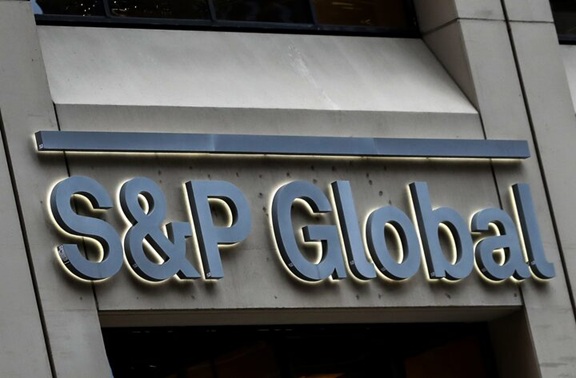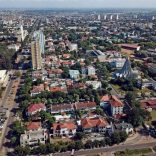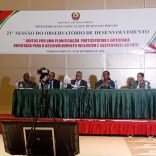Mozambique: Chapo promises to solve outstanding wage problems
Mozambique foreign currency rating affirmed at ‘CCC+’; outlook negative; local currency ‘SD’ rating affirmed

FILE - The S&P Global logo is displayed on its offices in the financial district in New York City, U.S., December 13, 2018. [File photo: Reuters/Brendan McDermid ]
Overview
- Ongoing fiscal slippage from wage bill pressures and subdued economic growth led to an increase in the Mozambique government’s payables to suppliers, as well as the accumulation of arrears on domestic and external official debt.
- Amid these constrained liquidity conditions, we consider ongoing domestic debt switch auctions distressed and tantamount to default, because we do not think the government would otherwise be able to honor these obligations on time and in full. We also understand there have been ongoing delays in payments on Mozambique’s local currency debt, in some cases for several months.
- The government’s foreign currency debt repayments on its commercial obligations remain modest, but further delays to planned gas projects and limited access to external financing could further weaken Mozambique’s external debt-servicing capacity.
- We therefore affirmed our ‘SD’ local currency rating and ‘CCC+’ foreign currency rating on Mozambique. The outlook on the FC rating is negative.
Rating Action
On Oct. 10, 2025, S&P Global Ratings affirmed its ‘SD/SD’ (selective default) long-term and short-term local currency (LC) sovereign credit ratings on Mozambique. At the same time, we affirmed our ‘CCC+/C’ long-term and short-term foreign currency (FC) sovereign credit ratings on Mozambique. The outlook on the FC rating remains negative. Our transfer and convertibility assessment is unchanged at ‘CCC+’.
Outlook
Foreign currency rating: The negative outlook reflects ongoing external financing constraints and risks of further delays to planned gas projects in and foreign aid to the country, which could adversely affect Mozambique’s ability to stay current on its foreign currency debt obligations in the next 12-24 months.
Local currency rating: We do not assign outlooks to ‘SD’ ratings because they express a condition and not a forward-looking opinion of default probability.
Downside scenario
Foreign currency rating: We could lower our FC rating on Mozambique if we saw a rising likelihood of the government not making payments on its commercial FC debt on time and in full. This could be the case, for example, if fiscal slippages further strained the government’s liquidity or the implementation of key planned gas projects were delayed, undermining Mozambique’s medium-term growth prospects.
Upside scenario
Foreign currency rating: We could revise the outlook on the FC rating to stable if Mozambique’s currently vulnerable fiscal position strengthened, for example, through government reforms or stronger medium-term prospects of rising gas output, ultimately allowing the government to avoid another restructuring of its commercial FC debt.
Local currency rating: We would view the LC default as resolved–and would therefore raise our long-term LC rating likely to the ‘CCC’ category–if the government resumed servicing its LC debt obligations on time and in full and if progress on fiscal consolidation, a reduction in external vulnerabilities, and better access to liquidity reduced the likelihood of Mozambique undertaking distressed debt exchanges to manage its upcoming redemptions.
Rationale
Mozambique continues to face fiscal pressures, which have led to rising arrears on domestic and external official debt. The October 2024 post-election protests, persistent delays in liquified natural gas (LNG) projects, and the suspension of Mozambique’s IMF program in April 2025 have all undermined the government’s efforts to reform its wage bill and improve public cash flow management. These developments have contributed to ongoing payment delays on government treasury bonds (sometimes extending up to three months), and the accumulation of arrears to domestic suppliers and official external creditors, including the IMF, World Bank, and Portugal.
Earlier in 2025, Mozambique undertook a domestic debt exchange that we viewed as distressed and therefore tantamount to default. This is because, in our view, absent the switch, the government would likely not have been able to fulfil the debt obligations on time and in full (see “Mozambique Local Currency Rating Lowered To ‘SD’ On Completed Domestic Debt Switch; Foreign Currency Rating Affirmed,” March 21, 2025). We had previously also considered delayed payments on LC bonds tantamount to default in 2023 because, in some instances, payments were up to three weeks late. The latest payment delays appear to be driven not only by Mozambique’s broader fiscal and liquidity constraints, but also persistent shortcomings in debt administration and governance.
In our view, prolonged delays in implementing planned LNG projects could heighten the likelihood of another restructuring of Mozambique’s FC debt. The country has a $900 million Eurobond due September 2031. Conditional on improved security in Cabo Delgado and other requirements, the $20 billion TotalEnergies LNG project (Area 1) could soon restart, paving the way for a final investment decision on ExxonMobil’s $30 billion LNG project (Area 4), given synergies between the two. These developments could yield substantial government revenue from gas exports once production begins in the 2030s. Conversely, persistent further delays on project implementation could have adverse implications for Mozambique’s growth prospects and fiscal position.
Despite ongoing fiscal and liquidity pressures for now, our baseline expectation is that the government will continue servicing its 2031 Eurobond obligations. These comprise annual coupon payments of $81 million and principal repayments of $225 million annually over 2028-2031. Our view is supported by the government’s stronger foreign exchange (FX) reserve position, which reached $3.9 billion as of July 2025. However, our assumptions regarding Eurobond debt-servicing remain contingent on the timely resumption of LNG megaprojects by 2026, which government officials expect to generate tax revenue during the construction phase.
Persistent domestic FX shortages weaken economic recovery prospects. The shortages, driven by subdued coal exports, delays in LNG project execution, and constrained external financing have curtailed imports and led to a significant contraction in credit to the economy. The Bank of Mozambique’s (BoM’s) decision to suspend FX sales for fuel imports since June 2023 has exacerbated these imbalances further. Although the central bank has introduced measures to boost FX availability, these interventions have had limited impact, with the reported FX backlog now exceeding $700 million. While FX pressures could ease with renewed LNG investment or the resumption of IMF disbursements, the latter appears unlikely because it would require the government to undertake politically sensitive reforms, such as rationalizing the wage bill and potentially liberalizing the exchange rate.
Institutional and economic profile: A difficult socioeconomic backdrop weighs on growth and exacerbates fiscal pressures
- Mozambique is characterized by very low per capita GDP of $660 as of 2025, and remains susceptible to erratic weather, while socioeconomic conditions remain fragile.
- Public protests erupted in the aftermath of the October 2024 presidential election against the official tally.
- We understand that TotalEnergies’s LNG investment could resume soon, after construction was suspended in 2021 due to escalating security risks. The related export revenue from the project could bolster Mozambique’s fiscal and external positions.
Social unrest broke out across the country following the October 2024 presidential election. Over 350 people were killed in post-election violence following ruling Frelimo leader Daniel Chapo’s appointment as president after reportedly receiving 71% of the popular vote. The protests were led by opposition leader Venâncio Mondlane, who disputed the result’s legitimacy and went into months of self-imposed exile.
In April 2025, parliament passed legislation introducing new frameworks for constitutional and political reform, including measures to limit presidential powers. Mr. Mondlane, previously resistant to engagement, has since confirmed his new political party’s intent to participate in the dialogue, despite confronting legal charges for his role in inciting post-election unrest. Although large-scale protests have subsided, sporadic demonstrations are likely to persist amid Mozambique’s fragile socioeconomic backdrop.
Real GDP has contracted for three consecutive quarters. Electoral unrest had a pronounced impact on Mozambique’s economic activity, as opposition-led demonstrations derailed transportation routes, mining operations, and trade networks with neighbouring countries including South Africa, Zambia, and Eswatini. These disruptions contributed to a sharp 5.7% GDP contraction year on year in the fourth-quarter of 2024, followed by a continued contraction averaging 2.4% in the first half of 2025. Consequently, we have revised our real GDP growth forecast for 2025 down to just 0.8%, reflecting expectations that persistent FX shortages, tight financing conditions, and weak private investment will continue constraining the manufacturing, construction, and import-related sectors. We also view Mozambique’s susceptibility to the effects of climate change as high, with frequent cyclones denting growth in the dominant agricultural sector (about 25% of GDP).
Mozambique’s long-term economic outlook could benefit significantly from its expanding gas export potential. Production at the Coral South floating LNG platform began in November 2022, with an annual capacity of 3.4 million tons and fiscal revenue contributions already peaking at 0.3%-0.4% of GDP annually. In October 2025, Eni approved the $7.2 billion Coral North LNG platform, expected to add 3.6 million tons of capacity once operational in the second half of 2028. To manage inflows, the government enacted a sovereign wealth fund law in December 2023, overseen by the BoM, which mandates that for the first 15 years, 60% of gas revenue due to the government will be allocated to the national budget, while 40% will go into the fund. Thereafter, the split will be 50-50. However, we understand further regulation is needed to make the fund fully operational, and that over $200 million in gas revenue remains deposited in a transitional account.
We understand that TotalEnergies’ $20 billion Area 1 LNG project could resume in the near future. The project, which aims to produce 12.9 million metric tons of LNG annually over 25 years, has been suspended since an Islamist insurgent attack in April 2021. Construction could resume in late 2025 or in 2026, contingent on continued improvements in the security situation in Cabo Delgado, supported by Rwandan military forces, and other developments. The restart of Area 1 is also expected to accelerate progress on ExxonMobil’s $30 billion Area 4 LNG project–Mozambique’s largest, with a planned capacity of 15.2 million tons per year–given the shared security and onshore infrastructure synergies between the two developments.
Flexibility and performance profile: Continued delays to payments on domestic debt
- Ongoing fiscal slippages and limited access to external financing has shifted the onus of deficit financing to domestic sources, raising government interest spending and crowding out domestic private investments.
- Mozambique’s current account deficits are expected to widen substantially as major gas projects gradually resume construction, but these will mostly be funded by foreign direct investment.
- Strong appreciation of the real effective exchange rate compared with the nominal exchange rate poses risks of a sharp currency correction.
Mozambique’s fiscal position remains fragile amid mounting spending pressures. Strikes and protests over salary adjustments–and, to a lesser extent, delayed government salary payments–have complicated efforts to rein in the structurally large public sector wage bill. In 2021-2024, spending on the wage bill plus benefits increased by 50% to Mozambican metical (MZN) 209 billion ($3.2 billion), consuming up to 52% of total government revenue. To alleviate the fiscal strain, the government announced in September 2025 the suspension of salaries for 18,000 ghost workers and a review of the wage records of another 11,000 employees. On the revenue side, tax collection has underperformed due to persistent challenges in the private sector, including tight financing conditions and limited FX availability. These higher-than-budgeted financing needs have strained public cash flow management, resulting in the accumulation of arrears to domestic suppliers and on both domestic and external official debt obligations (but not on commercial foreign currency debt to date).
Fiscal challenges will persist, absent meaningfully higher LNG revenue and a pronounced fiscal adjustment. We estimate the budget deficit on a cash basis will remain wide, averaging 4.2% of GDP over 2025-2028 (including grants and excluding loan repayments) from 4.7% in 2024, assuming ongoing revenue shortfalls, spending pressures, and weaker growth. However, we project the annual change in net general government debt will be larger at 6.0% of GDP, incorporating some exchange rate depreciation and an additional 1% of GDP worth of domestic supplier arrears contracted annually. While there is upside to our fiscal revenue projections from the LNG megaprojects (Area 1 and Area 4), these are unlikely to bear fruit before 2030. In the interim, the government expects to collect $483 million in LNG revenue from the Coral South and Coral North projects over 2022-2028.
The government’s ability to meet near-term payments on domestic debt has weakened. Since October 2024, the government has undertaken regular bond switch auctions to manage sizable domestic bond redemptions averaging 2.3% of GDP over 2025-2026. We continue to classify the exchanges as distressed because we do not think the government would be able to meet these repayments absent the switch auctions. However, participation in the exchanges has declined materially between the first and most recent operations–to 19% from 90%–reflecting suppressed demand for government securities amid banks’ already-high exposure to the government (about 30% of total banking sector assets).
In addition, we understand that, while authorities continue to make full payments on treasury bills, payments on government bonds have been delayed up to three months. These delays have led foreign-owned banks to record higher impairments on their sovereign exposures to Mozambique, eroding capital buffers, weakening profitability, and dampening appetite for further investments in government securities beyond short-term instruments. Absent significant policy changes, we anticipate the government will continue resorting to shorter-duration maturity treasury bills and central bank financing to fund near-term fiscal deficits, while engaging with banks bilaterally to term out existing maturities and clear the existing stock of domestic bond arrears (estimated at MZN12 billion, or 0.8% of GDP).
Mozambique’s IMF program was terminated early in 2025, given that the government did not meet conditions stipulated by the program. In April 2025, the IMF agreed not to disburse the remaining $126 million under Mozambique’s final two reviews of its $456 million Extended Credit Facility, citing inadequate progress on policy reforms. Since IMF funding is often a catalyst for other official and private flows, we expect there could be delays to World Bank and other sources of official financing. In addition, the suspension of U.S.-related funding (especially from the U.S. Agency for International Development), which amounted to $664 million in 2023, has compounded an already difficult external financing environment. We understand the government accumulated $54 million in official external arrears to multilateral and bilateral creditors in 2024, but has repaid some.
Consequently, the government has been increasingly relying on shorter-duration treasury bills and central bank financing to finance fiscal deficits. Given curtailed external financing and subdued demand for government bonds, authorities have been resorting to deficit monetization. Although central bank borrowing is capped at 10% of the average of the previous two year’s fiscal revenue, we understand the government has used this facility to its maximum allowable limit, resulting in a notable rise in the BoM’s claims on the Ministry of Economy and Finance–accounting for 22% of total domestic debt as of first-half 2025. Concurrently, treasury bills have grown to represent about one-third of domestic debt, heightening rollover risks and reducing the weighted-average maturity of domestic debt to just two years. Given Mozambique’s elevated domestic financing costs, we anticipate interest expenditure will average an elevated 17.8% of government revenue over 2025-2028.
Mozambique’s external debt profile remains largely concessional. Foreign currency debt accounts for about 59% of total debt, of which about 91% is on concessional terms with multilateral (56% of the total) and bilateral (35%) entities. However, domestic debt has surged in recent years, rising by almost 80% to MZN445 billion (29% of GDP) in first-half 2025 from MZN246 billion (19%) in the first half of 2022. We project net general government debt will increase to 68% of GDP by 2028, from 64% in 2024, given our assumption of persistent fiscal deficits, subdued economic growth, and further accumulation of domestic arrears to local suppliers (estimated at about 3% of GDP).
Settlements on loans from ProIndicus and Mozambique Asset Management Co. (MAM) have contained the buildup in external debt. In 2013 and 2014, three state-owned enterprises–ProIndicus, MAM, and EMATUM–borrowed about $2.2 billion (12% of GDP) from Credit Suisse and VTB backed by undisclosed state guarantees. The funds, intended for maritime security and tuna fishing projects, were largely misused, subsequently leading to a default of Mozambique on its foreign currency debt in 2017 (see “Mozambique Foreign Currency Ratings Lowered To ‘SD/D’ On Missed Payment,” Jan. 18, 2017). The government has subsequently challenged the legality of the guarantees and has been involved in multiple legal proceedings to settle these liabilities:
- In October 2023, Mozambican authorities reached an out-of-court agreement that covered about $522 million in principal of ProIndicus’ debt outstanding. As part of the settlement, the government agreed to pay $142 million to UBS (UBS acquired Credit Suisse in March 2023), funded through the issuance of $96 million in treasury bonds and $46 million of cash.
- In June 2024, the government reached a settlement on the VTB component of the Proindicus loan ($113 million in principal outstanding) and the entirety of the MAM loan ($535 million). This was funded through a cash payment of $220 million, raised through the issuance of treasury bonds.
FC debt repayments remain contained until Mozambique’s sole Eurobond starts amortizing from 2028. Mozambique’s sole Eurobond is the successor to a $850 million government-guaranteed bond originally issued in 2013 by EMATUM, one of the three state-owned entities linked to the hidden debt scandal. In 2019, Mozambique restructured the EMATUM bond into a new $900 million Eurobond maturing in 2031. Despite tight liquidity conditions, the government continues to service the coupon on the bond, which stands at 9% ($81 million per year). Amortization on the bond will be $225 million per year from 2028-2031.
Contingent liabilities are sizable, with government guarantees amounting to 8% of GDP ($1.8 billion). Most of the guaranteed government debt has been extended to national oil and gas company Empresa Nacional de Hidrocarbonetos (ENH). ENH’s assets and liabilities have been placed in special-purpose vehicles, with the company’s share of revenue from LNG projects being ringfenced for the repayment of its debts. We understand that the Coral South floating LNG and TotalEnergies’ Area 1 projects have long-term purchase agreements with gas buyers, which will help generate revenue for ENH to repay debt funding its stake in the LNG development.
We expect Mozambique’s external deficits to widen as import requirements for the LNG megaprojects increase. We forecast the current account deficit will widen to 17% of GDP over 2025-2028, from 11% over 2023-2024. The large narrowing of the deficit in 2023 and 2024 is due to receding imports following the completion of the Coral South floating LNG project in 2022, increasing LNG exports from the project as production ramps up, and lower supply of dollars by the BoM to meet imported fuel requirements. From 2025 onward, we expect the widening current account deficit will be mostly funded by foreign direct investment to develop the large gas projects. We forecast Mozambique’s usable reserves will amount to $3.9 billion by end-2025, from $3.6 billion at end-2024, thereafter falling back to about $3.7 billion upon amortization of the Eurobond from 2028.
Monetary policy has eased but remains restrictive overall. The BoM began its loosening cycle in January 2024, cutting the policy rate by a cumulative 750 basis points to 9.75%. Inflation is projected to stay moderate at 4.8% in 2025, supported by favorable commodity prices, subdued overall demand, and exchange rate stability that helps contain import-driven inflation. However, despite the rate cuts, the BoM’s cash reserve requirements for banks remain elevated compared with that of regional peers, constraining credit expansion to the real economy. In January 2025, the BoM reduced mandatory reserve requirements on bank liabilities to 29.0% (from 39.0%) for LC and to 29.5% (from 39.5%) for LC. These levels, though lower, still reflect a relatively tight monetary stance.
The metical has been stable vis-à-vis the U.S. dollar since mid-2021. The IMF estimates that Mozambique’s real effective exchange rate is overvalued by approximately 38% but the government appears reluctant to pursue exchange rate liberalization due to risks from inflationary spillovers. Nevertheless, securing a new IMF program will likely require a firm commitment to greater FX flexibility, in our view. We forecast a modest depreciation of the metical through 2028 given reported FX shortages and sizable current account deficits, but the currency will remain propped up by exchange controls that have been de facto implemented by the central bank.
FX supply-demand imbalances are curtailing credit growth. Limited FX availability–driven by weaker export performance, reduced external assistance, and the BoM’s decision to cut FX sales for fuel imports since June 2023–has contributed to a reported FX backlog now exceeding $700 million. Despite administrative measures aimed at improving FX liquidity–including raising exporters’ mandatory conversion rate to LC to 50% from 30% in April 2025 and tightening commercial banks’ long FX net open position limits in July 2025–the shortage persists. This has stifled credit growth to the private sector, which stagnated at 0% year on year in June 2025, and further eroded the loan-to-deposit ratio to 37%. Also, private sector lending has been crowded out by increased government borrowing, with nearly 30% of total banking system assets now held in government securities.












Leave a Reply
Be the First to Comment!
You must be logged in to post a comment.
You must be logged in to post a comment.